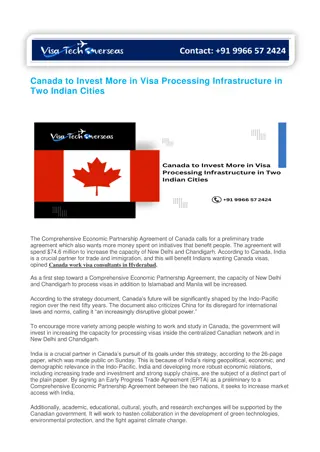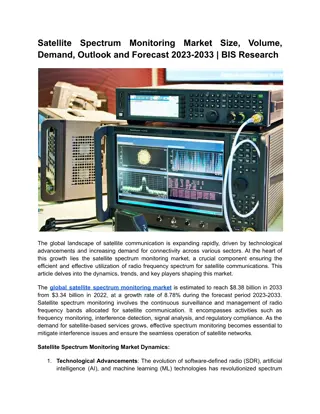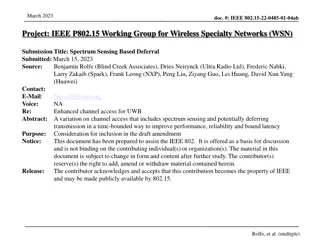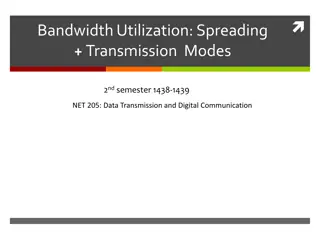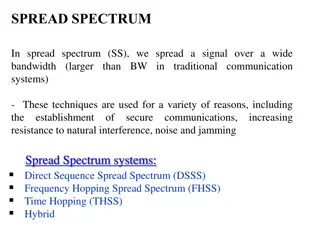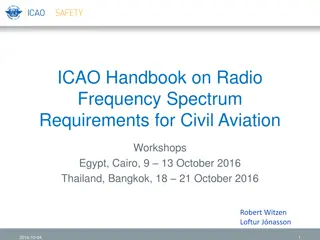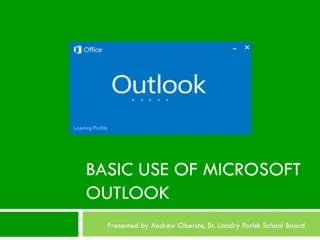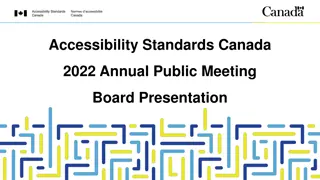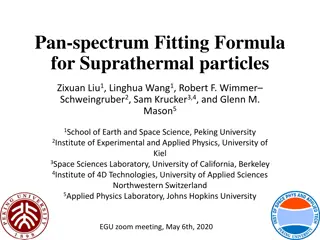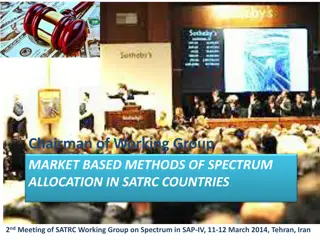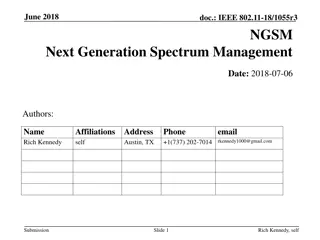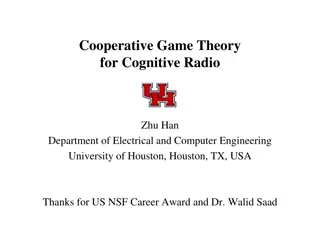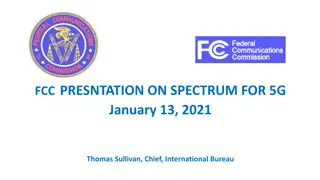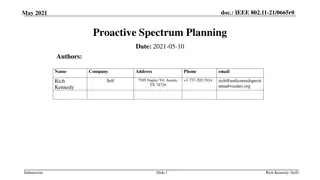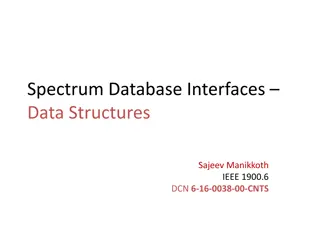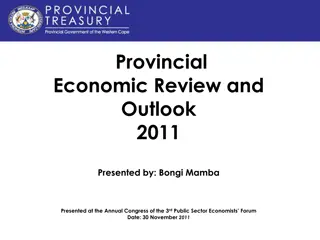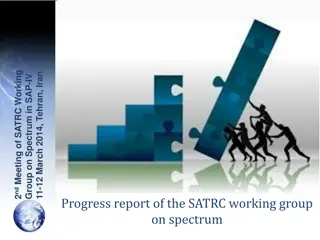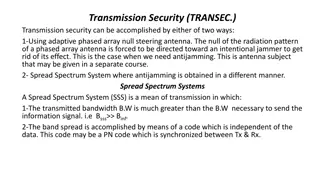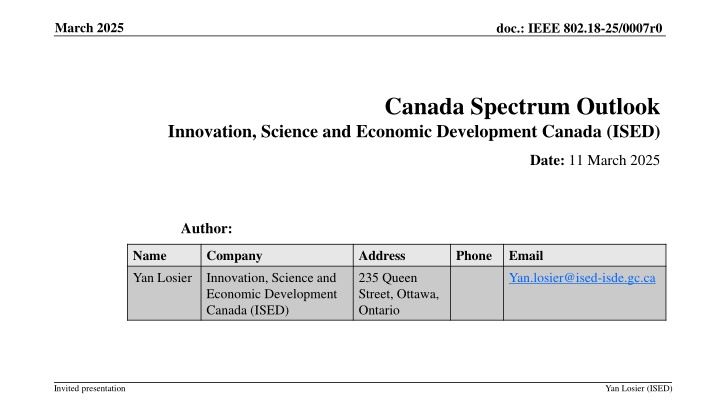
Canada Spectrum Outlook 2025: ISED Regulatory Framework & Spectrum Management
Discover the comprehensive overview of Canada's spectrum outlook for 2023-2027, including insights on the regulatory legal framework, electromagnetic spectrum management, and ISED's priorities. Gain valuable information on spectrum demand, planned releases, and addressing technical issues for services and applications.
Uploaded on | 1 Views
Download Presentation

Please find below an Image/Link to download the presentation.
The content on the website is provided AS IS for your information and personal use only. It may not be sold, licensed, or shared on other websites without obtaining consent from the author. If you encounter any issues during the download, it is possible that the publisher has removed the file from their server.
You are allowed to download the files provided on this website for personal or commercial use, subject to the condition that they are used lawfully. All files are the property of their respective owners.
The content on the website is provided AS IS for your information and personal use only. It may not be sold, licensed, or shared on other websites without obtaining consent from the author.
E N D
Presentation Transcript
March 2025 doc.: IEEE 802.18-25/0007r0 Canada Spectrum Outlook Innovation, Science and Economic Development Canada (ISED) Date: 11 March 2025 Author: Name Yan Losier Company Innovation, Science and Economic Development Canada (ISED) Address 235 Queen Street, Ottawa, Ontario Phone Email Yan.losier@ised-isde.gc.ca Invited presentation Yan Losier (ISED)
doc.: IEEE 802.18-25/0007r0 Overview ISED Regulatory Legal Framework Electromagnetic Spectrum Regulated by ISED Spectrum Outlook Spectrum Priorities 2023-2027 Spectrum Policy Process Domestic Standards Development Process 6 GHz Band Dynamic Spectrum Access Ultra-Wideband (UWB) International Standard Activities Invited presentation
doc.: IEEE 802.18-25/0007r0 The Regulatory Legal Framework Radiocommunication Act Radiocommunication Act The Minister of ISED, through the Department of Industry Act, the Radiocommunication Act and the Radiocommunication Regulations, with due regard to the objectives of the Telecommunications Act, is responsible for spectrum management in Canada. Radiocommunication Regulations Radiocommunication Regulations Radiocommunication Regulations Telecommunications Act Telecommunications Act Invited presentation
doc.: IEEE 802.18-25/0007r0 Electromagnetic Spectrum from extremely low frequency to gamma rays MOBILE PHONEMICROWAVE GAMMA RAYS X-RAYS VISIBLE LIGHT POWERLINE TELEVISION SMART METER Managed by ISED NOT managed by ISED RADIO COMPUTER BABY MONITOR WI-FI ISED regulates radio apparatus, interference causing equipment and radio sensitive equipment up to 3 000 GHz Invited presentation
doc.: IEEE 802.18-25/0007r0 Spectrum Outlook (Reviewed Periodically by ISED) Overview of ISED s approach to meeting expected spectrum demand from 2023-2027 ISED s Sets priority for our planned spectrum releases and related work for 2023 to 2027 High-level plans to address licensing and technical issues raised by stakeholders assessment of demand and spectrum needs for services / applications Invited presentation
doc.: IEEE 802.18-25/0007r0 ISED Spectrum Priorities 2023-2027 Source: Spectrum Outlook 2023 to 2027 Invited presentation
doc.: IEEE 802.18-25/0007r0 Spectrum Policy Process Overview ISED Spectrum Outlook Outlines ISED s plan to make spectrum available to support services and applications requiring new spectrum in the coming years. The Spectrum Outlook is refreshed every few years. Policy Consultations/Decisions and Industry Changes These decisions establish technical and licensing frameworks and policies. Released directly on ISED website periodically. Depending on industry developments or spectrum outlook, these may be modified Technical Standards and Procedures These standards and procedures set out technical requirements for equipment to be put on the Canadian market. Modifications are made based on ISED policy decisions in consultation with the industry. Invited presentation
doc.: IEEE 802.18-25/0007r0 Domestic Standards Development Life Cycle for Equipment Triggers Research and analysis ISED Policy Consultations & Decisions International Standards Development Activities Maintenance of Standard Draft Standard New Innovative Products from Industry Approval and Publication of Final Standard External Consultation (70 days) New Rulemaking from Key Trade Partners 8 Invited presentation
doc.: IEEE 802.18-25/0007r0 6 GHz Band in Canada In May 2021 ISED published the Decision on the Technical and Policy Framework for Licence-Exempt Use in the 6 GHz Band ISED s objectives for licence-exempt use of the 6 GHz band in Canada are: - Fostering innovation and investment in new wireless technologies and services - Supporting greater choice and affordability of wireless services for consumers and businesses - Facilitating deployment and timely availability of wireless broadband Internet across the country Invited presentation
doc.: IEEE 802.18-25/0007r0 Overview of the Decisions for 6 GHz spectrum use - Allow licence-exempt RLAN use in the entire 5925-7125 MHz band - Allow licence-exempt standard power RLANs under AFC system control in the 5925-6875 MHz frequency range - Allow licence-exempt low-power indoor-only RLANs with the use of a contention-based protocol in the 5925-7125 MHz band - Allow licence-exempt very low-power indoor and outdoor RLAN devices with the use of a contention-based protocol in the 5925-7125 MHz band - Adopt AFC system to protect incumbent fixed services and radioastronomy sites Invited presentation
doc.: IEEE 802.18-25/0007r0 Dynamic Spectrum Access (DSA) in the 6 GHz Band Two types of DSA systems are currently authorized in Canada - Automated Frequency Coordination (AFC) - Database of protected licensed systems in the 5925-6875 MHz band - Determines available frequencies and associated maximum power levels at specific time and geographic location - White Space - Database of unused spectrum by other licensed radio services - Currently focused on unused over-the-air television bands Invited presentation
doc.: IEEE 802.18-25/0007r0 AFC Technical and Operational Requirements AFC - DBS-06 sets out the technical requirements for the designation of an automated frequency coordination system administrator (AFCSA) and for the operation of an AFC system capable of identifying available frequencies and associated maximum power levels for use by standard-power radio local area network (RLAN) devices operating in the 5925-6875 MHz frequency band. DBS-06 - CPC-4-1-02 outlines procedures to be followed by applicants who wish to be considered by ISED for designation as AFCSAs to operate automated frequency coordination (AFC) systems. CPC-4-1-02 - RSS-248 sets out the certification requirements for licence-exempt radio local area network (RLAN) devices operating in the 5925-7125 MHz frequency band (the 6 GHz band). RSS-248 Invited presentation
doc.: IEEE 802.18-25/0007r0 White Space White Space Technical and Operational Requirements - DBS-01 sets out the technical requirements for the designation of a database capable of identifying available channels for use by white space devices (WSDs) in the frequency bands 54-72 MHz, 76-88 MHz, 174-216 MHz, 470-608 MHz and 657-663 MHz. DBS-01 - CPC-4-1-01 outlines procedures to be followed by applicants who wish to be considered by ISED for designation as a WSDBA to operate a white space database (WSDB). CPC-4-1-01 - RSS-222 sets out the certification requirements for licence-exempt, radio apparatus operating in the frequency bands 54-72 MHz, 76-88 MHz, 174-216 MHz, 470-608 MHz and 657-663 MHz, known as WSDs. RSS-222 Invited presentation
doc.: IEEE 802.18-25/0007r0 Spectrum Management System (SMS) Data ISED provides various tools to search for or download data related to spectrum authorizations it issues. With these tools, users can: - Search SMS data related to the different types of radio authorizations - Download SMS data for radio authorizations in the 6 GHz band - Upload spectrum licence site data Invited presentation
doc.: IEEE 802.18-25/0007r0 Ultra-Wideband Radio Standards Specification (RSS) 220 establishes provisions for short-range devices using ultra-wideband (UWB) technology in Canada. It covers: Communication, measurement, location sensing and tracking devices Ground penetrating radar (GPR) devices In-wall radar imaging and through-wall radar imaging devices Medical radar imaging devices Radar surveillance devices Since 2022, vehicular radar devices using ultra-wideband technology in the 22-29 GHz frequency is no longer permitted. This was the result of the global migration of vehicular radar to the 76-81 GHz frequency band. There are no current plans to revise this standard or associated policies. Invited presentation
doc.: IEEE 802.18-25/0007r0 International Standards Activities ISED continues to be active in international standards activities within IEC (TC106, CISPR), IEEE SC34, ANSI C63, TIA and others Whenever possible, International Standards are leveraged within regulatory standards and domestic procedures to improve efficiency, promote fair competition and increase interoperability Invited presentation
doc.: IEEE 802.18-25/0007r0 Thank you Questions? Invited presentation

